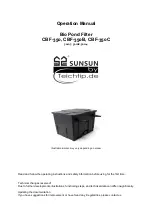
8
8
POOL MAINTENANCE:
1. Check and adjust pH and chlorine levels daily using required chemicals. See “POOL WATER CARE”, below.
2. Check filter output daily. If flow is reduced, see Symptom 2 in “TROUBLE SHOOTING GUIDE”, page #9.
3. Check filter for leaks. If a leak is found, see Symptom 4 in “TROUBLE SHOOTING GUIDE”, page #9.
4. Check seams in pool periodically. Minor repairs may be made with the patch kit (supplied with pool). Additional
patches are available from General Foam Plastics or your local pool supply store.
POOL WATER CARE
1. The following items are required and readily available from your local pool supply store:
A. TEST KIT - Used to check chlorine and pH levels.
B. 1” CHLORINE TABLETS - Used to disinfect pool water and help control the growth of algae.
C. pH CONTROL CHEMICALS - Used to adjust pH levels Up (Soda Ash) or Down (Acid).
D. ALGAECIDES - Used to eliminate algae.
E. SUPERCHLORINATOR - Used to destroy combined chlorine, ammonia, nitrogen, and organic compounds.
F. LEAF NET with handle - Used to remove leaves, trash, insects, etc. from pool.
G. CHLORINE DISPENSER (Supplied with Filter) - Used to dispense 1” chlorine tablets ONLY.
2. Use test kit daily to check pH and chlorine levels. Adjust accordingly using the required chemicals.
NOTE:
Excessive levels of chlorine or low pH levels will damage pool liner.
3. The pool can be cleaned using a garden hose powered vacuum from General Foam Plastics or a pool supply store.
4. Using a foot bath near the pool to wash off your feet prior to entering the pool will assist in keeping the pool clean.
5. Well water often presents special problems with water chemistry. If you must use well water, take a sample to
your local pool chemical supplier for analysis before adding ANY chemicals.
6. Use the gallons for your pool to calculate the amount of chemicals you will need to correct the pool water based
on the gallons of water in your pool. Note: It is recommended to use a 5 gallon bucket of water to mix and dis-
solve your chemicals and then applying directly to the pool water. Follow manufacturers label directions on all
chemicals.
For your convenience, fill in your pool’s information in the below chart. This info is in your pool set-up instruc-
tion manual.
*Most pool supply stores will test your pool water for free and advise you of what chemicals you need, and the
correct amount to use for your pool. You will need to tell them the pool capacity in gallons.
7.
IMPORTANT
- We cannot over-stress the importance of proper and adequate daily chemical treatment. Chlo-
rine and pH levels must be maintained at all times.
PUMP AND FILTER ALONE WILL NOT PREVENT
ALGAE FROM GROWING IN POOL WATER; THIS CAN ONLY BE DONE BY MAINTAINING
PROPER CHLORINE AND pH LEVELS AT ALL TIMES.
A. Maintain pH level between 7.3 and 7.8.
B. Maintain chlorine level between 1.0 and 1.6 ppm (parts per million).
C. Superchlorinate your pool at least every other week.
NOTE:
1. Hot weather/heavy use may require pH and chlorine levels to be maintained on the upper side of the scale and
superchlorination of the pool every week.
2. Using a pool cover and/or solar cover will assist in maintaining your pH and chlorine levels by reducing the
amount of evaporation from your pool.
CAUTION
- Concentrated chlorine levels and low pH levels will damage pool.
DANGER
- You must follow the instructions for the pool chemicals you use, as to quantity and recom-
mended usage.
NEVER
drop lumps or pellets of chemicals in pool; this may present a hazard to swimmers and/or damage your liner.
POOL TYPE
FILTER/PUMP TYPE
POOL CAPACITY/GALLONS



























